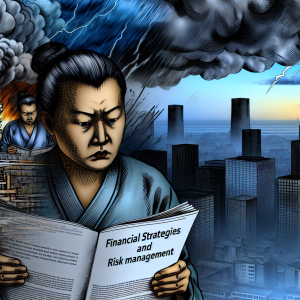As the second half of 2024 unfolds, investors in Chinese equities face a landscape marked by cautious optimism mixed with underlying volatility risks. While the overarching narrative around China’s tech sector remains largely unchanged, the subtleties in market dynamics and policy signals suggest a strategic pivot is warranted—especially for those looking to optimize returns amid increasing uncertainty.
Navigating the Volatility Ahead: What Investors Need to Know
Morgan Stanley’s chief China equity strategist, Laura Wang, recently issued a prudent warning: brace for a potential surge in market volatility over the next couple of months. This caution stems from the tepid response of Chinese policymakers to stimulate growth, with no major policy boosts expected from the upcoming Politburo meeting. Compounding this unease is the looming expiration of the 90-day U.S.-China tariff truce in mid-August, alongside a critical July 9 deadline for U.S. trade agreements with other nations. These geopolitical and economic factors are creating a backdrop that demands a more conservative stance from local Chinese investors.
Dividend Plays: The New Defensive Frontier
One of the standout themes emerging from recent analyses is a renewed focus on high-dividend stocks as a defensive strategy. Morgan Stanley’s endorsement of dividend yield plays, such as Hong Kong-listed insurer PICC P&C, which boasts a robust 4.5% dividend yield, highlights the appeal of steady income streams amid market turbulence. PICC’s growth potential in the auto insurance sector further sweetens the deal, making it a compelling pick for risk-averse investors.
UBS Securities’ China equity strategist Lei Meng echoes this sentiment, emphasizing that medium- and long-term investors are gravitating toward high-dividend stocks and banks. This shift is bolstered by increased state-backed stock purchases, which adds a layer of institutional support to these sectors. Notably, Meng forecasts a slowdown in tech sector inflows for the latter half of the year, signaling a strategic rotation away from the high-flying tech names that dominated the first half.
Tech Stocks: A Tale of Two Markets
The divergence between mainland China and Hong Kong markets is stark. Hong Kong’s Hang Seng Index, heavily weighted with tech giants like Alibaba and Tencent, surged approximately 20% in H1 2024. In contrast, the Shanghai Composite, dominated by state-owned financial and industrial firms, eked out a modest 3% gain. This bifurcation underscores the contrasting investor appetites: international and tech-focused investors are chasing growth and innovation in Hong Kong, while domestic investors seek stability and yield on the mainland.
Mainland Investors Eye High-Yield Opportunities Amid Restrictions
J.P. Morgan’s Wendy Liu highlights a significant trend: mainland Chinese investors are increasingly targeting high-yield stocks listed in Hong Kong to achieve better returns than those available domestically. Examples include PetroChina with a 7.3% dividend yield and China Resources Power (CR Power) at 6.1%. This strategy is particularly relevant as mainland investors face growing limitations accessing U.S. and other international markets.
What Should Investors and Advisors Do Differently?
-
Rebalance Portfolios Toward Yield and Stability: Given the anticipated volatility and geopolitical uncertainties, a tactical shift toward high-dividend, state-supported sectors like insurance, utilities, and banks is advisable. These sectors offer both income and relative safety, cushioning portfolios against downside risks.
-
Monitor Policy Signals Closely: Investors should keep a keen eye on the Politburo meeting outcomes and U.S.-China trade negotiations. Any unexpected policy shifts or tariff developments could trigger sharp market moves, requiring nimble portfolio adjustments.
-
Be Selective with Tech Exposure: While AI and tech remain exciting growth arenas, the sector’s momentum may slow in H2. Investors should focus on high-quality names with strong fundamentals and avoid speculative bets on unlisted giants like ByteDance, which remain inaccessible to public investors.
-
Diversify Geographically and Sectorally: Global institutional investors continue to view U.S. equities as low-risk anchors. Incorporating a blend of U.S., European, and emerging market equities alongside select Chinese high-dividend stocks can enhance risk-adjusted returns.
Looking Ahead: What’s Next for China Equities?
The coming months will test investor resolve as China navigates a complex interplay of domestic policy inertia and external trade pressures. However, this environment also presents unique opportunities for those willing to pivot from growth-at-all-costs to income and value-oriented strategies. As UBS’s Lei Meng points out, understanding fund flow structures and market styles will be crucial in capitalizing on these shifts.
A recent statistic from the Asian Development Bank reveals that China’s economic growth is projected to moderate to around 4.5% in 2024, underscoring the need for cautious optimism. Investors should prepare for a market environment where steady dividends and policy-backed sectors outperform speculative tech rallies.
At Extreme Investor Network, we believe that the smartest investors will be those who combine macroeconomic vigilance with tactical sector rotation—balancing growth potential with income stability. Stay tuned for our ongoing coverage as we track these evolving trends and deliver actionable insights tailored to your portfolio’s success.
Sources:
- Morgan Stanley Reports, June 2024
- UBS Securities China Equity Outlook, July 2024
- J.P. Morgan China Equity Strategy, June 2024
- Asian Development Bank Economic Forecast, 2024
- WisdomTree Quantitative Investment Insights, June 2024
Source: Where China’s own investors are urged to hide out in the second half

